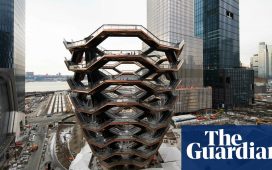Pottery can’t help but feel miraculous: a lump of mud, set spinning on a wheel, transformed by motion and friction into something useful. “A potter is one of the few people left who uses his natural faculties of heart, head and hand in balance – the whole man,” wrote Bernard Leach, the father of British studio pottery. “Good pots require the ardour of vocation and the devotion of a lifetime.”
No doubt. But on a first lesson at Turning Earth E10 – a 790 sq metre (8,500 sq ft), collective-run “pottery gym” on an industrial estate in Leyton, east London – a passable pot is just about doable in a morning. It requires about half a kilo of clay and a patient teacher, Natalie Smith, a relatively recent convert herself. Like many 21st-century potters, she uses Instagram (@throwing_pots) as a shop window for her fermentation jars and teapots.
Sun streams through the skylights on to a scene of blissful purpose, decorated with Extinction Rebellion posters. A highly focused man at the next wheel is rippling through a Japanese-style dinner service with impressively slender walls; a recently retired woman paints a vase with a little more visible effort.
Smith runs me through basics of water and pressure, the rituals of kneading the clay, positioning it on the wheel, “coning” up and down to ensure the clay is dead-centre. “This part drives people crazy to begin with,” she says. “Now I find it quite meditative.” Then comes the miraculous part, thumbing out a little hole, tickling out a wall.
Each pot has an element of happenstance. You might end up with something vaguely urn-like and pretend that is what you were aiming for all along. You might accidentally step on the pedal – a common mistake – and watch your little miracle lurch back into mud. “Don’t worry, we recycle all the clay,” Smith assures me.

I first noticed the re-emergence of pottery as a popular hobby while living in Los Angeles a couple of years ago: a friend invested in a wheel and began hosting ceramics-themed parties. It was a spell in California, too, that inspired Tallie Maughan, the founder of Turning Earth, to create her first “open-access” studio in Hoxton, a few miles south-west of Leyton, in 2013. The term “gym” refers to the membership model rather than the well-evidenced mind-body benefits of throwing clay – you can pay a not-inconsiderable £165 a month for a one-year contract that gives you access to materials at cost price, as well as a set of technicians who can help with the exacting glazing and firing process (other membership options are available). A number of studios have since opened along similar lines, including Clay Studio in Manchester; meanwhile, the BBC is relaunching its craft contest The Great Pottery Throwdown.
It is not hard to see why pottery may appeal in these hyperconnected, terminally distracted times. It is literally impossible to look at your phone while you are making a pot. If you try to sneak a look at your mentions between throws, your phone will quickly become smirched in clay. Also, as Maughan notes, “generation rent” was brought up on home-renovation programmes – but a lot of us don’t own homes. “Pottery is something small and manageable that connects to that idea of home.”
Social media has helped potters to establish low-overhead businesses – ceramicists such as Tom Kemp (@tom_kemp_) and Stine Dulong (@skandihus_london) command huge followings on Instagram.
Elizabeth Macneal, the author of the bestselling novel The Doll Factory, has been selling the pots she makes in what used to be her writing shed for three years, mostly through Instagram (@elizabethmacneal). In 2016, while working as a management consultant, she found herself drifting into a pottery class during a project in Edinburgh. She soon became addicted. “There were about 100 people on the project I was working on. I had no idea what I was even supposed to be doing. But, with pottery, you are solely responsible for how it turns out. That’s so inviting when you’re disaffected by your job.”
She finds that writing and throwing pots complement one another. “When I’m writing, sometimes it feels as if I’m not getting anywhere – I can delete a month’s work in about 10 seconds. But then I can go to the shed, throw 10 mugs and have something to show for it. It’s almost the opposite of writing. It’s mechanical and it’s repetitive, so you can let your mind wander. I often work out plot points that way and I like that primarily it’s functional. It’s relaxing. It doesn’t have to stand on its aesthetic merits alone, like a painting. Can I drink from it? Yes? Well, it’s a mug, then.”

Louise Ogden, who in 2017 opened a small hand ceramics studio called Kiln off Gloucester Road in Bristol, echoes the point. “We’ve made ourselves so busy, but there’s not much output, is there?” she says. “We achieve bugger all.”
She says opening an art-centred business off a busy high street was a risk, but one worth taking. “We have squeezed art out everywhere. It’s not in schools any more. And it’s such an antidote to the technological onslaught that has become the norm. It’s a very old thing, clay. People often say they feel like they’ve been in a spa for a full day.”
Pottery, she suggests, challenges our post-industrial ideas about art, where we outsource all creativity and handiwork to a few specialists. “People often show up for classes protesting that they’re not creative, but they end up really surprised at what they’ve been able to make. Creativity is like a muscle. Children love to create. But unless you make a point of doing it as a grownup, it withers. The idea is that everyone is welcome there. It’s suitable for little babies up to elderly people.”
For Maughan, who is writing a book on pottery, to be published next year, the connection goes back even further. “Ceramics is the oldest form of technology we have,” she says. “After cooking meat, baking clay was the first thing that humans did to chemically alter our environment on purpose. You can’t make rice without cooking it in some kind of vessel, so clay pots go hand in hand with agriculture – our whole evolution is connected to it. There’s only a short period of history in which people haven’t been connected with pottery. There’s something incredibly grounding about an experience that connects you with the past like that.”
Maughan echoes the views of William Morris, the Arts and Crafts designer and socialist activist, who was born in 1834 not far from the site of Turning Earth E10. He argued that making beautiful things should be seen as a fundamental human need. “I do not want art for a few, any more than education for a few, or freedom for a few,” he wrote in Hopes and Fears for Art.

While Maughan welcomes pottery’s popularity – US Vogue has declared it “the new yoga” and it has, perhaps inevitably, become the latest mindfulness trend in Silicon Valley – she is determined to ensure it doesn’t end up as “a middle-class hobby”, even if the associated costs clearly push it in that direction. “I am political; I did this for political reasons,” she says. “It’s called Turning Earth for that reason. We shouldn’t think of objects as nameless, faceless things, detached from process. We should think about how they got there, what their impact is and who was involved.”
Her vocation is deep-rooted. She grew up with her mother in Rutland; her childhood involved no central heating, but lots of home-curing and potato-farming. “My dad died when I was six. My mum was quite an eccentric person who felt she needed to prepare us for a post-apocalyptic world. She had a pottery wheel and kiln in the conservatory. She formed her own Saturday morning pottery class and made me and my brother go every week.”
Maughan wasn’t especially keen at the time, but when she took a pottery course as an adult she found it gave her an “almost mystical feeling” that was sorely lacking in her day job. She was then working as a corporate social responsibility consultant – advising multinational companies on how they could be more green and ethical – but she had become deeply disillusioned. “The whole thing came out of me thinking about climate change and feeling that we had to do something drastically different as a society,” she says. “It may seem counterintuitive, but I realised that we needed to start creating sustainable activities that people actually want to do, rather than trying to fix a system that was broken. If you look at the root cause of climate change, it’s unsustainable consumption. Why do people consume so much? The main reason is they’re not happy. So, what makes people happy? Once you start asking those questions, it inevitably leads you to questions about the inequity in society.”
She notes that her studios have proved popular partly due to the squeezing of further education colleges. “One of the reasons we didn’t have this sort of culture before is that we’re used to having state-funded arts programmes, which has led to many people seeing art as a parasite and not something that can be an economic contributor.” She is committed to creating “art in the black” – art that funds itself – but balancing this aim with her desire to bring pottery to as wide an audience as possible clearly has its challenges. The next Turning Earth studio will be in Battersea, south-west London, in partnership with Big Yellow Storage and Wandsworth council, which will allow Maughan to offer funded places. “If we don’t do things like that, it will end up as one of those gentrification projects that divide society. We don’t want it to be that.”








